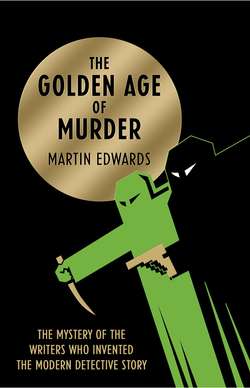Читать книгу The Golden Age of Murder - Stephen Bach, Martin Edwards - Страница 34
Notes to Chapter 6
ОглавлениеThe first person who set out to solve ‘the riddle of the Detection Club’ was Clair Price
See Clair Price, ‘A New Code for Crime between Covers’, New York Times, 24 July 1932.
Julian Symons, a historian as well as a crime writer of distinction and former Club President, mistakenly wrote that the Club started in 1932.
Symons said this in his introduction to Verdict of 13: A Detection Club Anthology (London, Faber, 1979), where he also expressed the belief that John Dickson Carr was ‘the only member ever elected who was not British’. A more reliable account of the Club’s early days was supplied by John Rhode’s Foreword to an earlier Club anthology, Detection Medley.
In other respects, Mary Fitt … was as reticent as Berkeley
Even so, she was persuaded by Picture Post to be photographed on her hands and knees, peering through a magnifying glass at a Greek vase.
The novel was an expansion of ‘The Avenging Chance’
Curiously, the story appears to have been published after the novel. A latter-day Berkeley might come up with multiple explanations for this little mystery. Perhaps he realized the strength of his short story’s plot, and delayed its publication until he had exploited it more fully, and more lucratively, through the novel.
On 27 December 1929, Berkeley wrote to G. K. Chesterton
No original correspondence relating to the early days of the Detection Club remains in the Club’s possession; while the Minute Book has apparently not been seen since the Second World War. The Club’s archive is, at the time of writing, in the process of development. I have gleaned information about the correspondence mentioned in this book from a wide variety of sources, in particular the Marion E. Wade Center at Wheaton, from Arthur Robinson, Tony Medawar, George Locke, Douglas G. Greene and Curtis Evans, as well as from occasional sales of material on www.abebooks.com.
‘Plotting a Detective Story’
See Tony Medawar, ‘Plotting a Detective Story – Dorothy L. Sayers and Anthony Berkeley’, CADS 51, April 2007.
four members collaborated in a fundraising event for a hospital charity on 31 May 1932
A fifth collaborator was Captain Alan Thomas (1896–1969). His The Death of Laurence Vining (1928) was a well-regarded ‘impossible crime’ novel, and he later became editor of The Listener. Death of the Home Secretary (1932) is one of a host of Golden Age mysteries in which politicians meet an untimely end.
